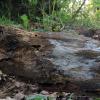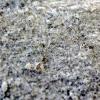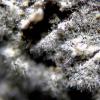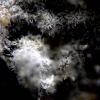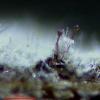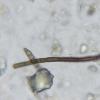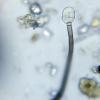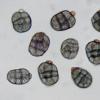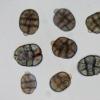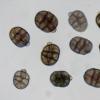
22-07-2011 23:48
 Alex Akulov
Alex Akulov
Dear Friends During investigation of my sample, I

21-07-2011 07:31
 Alex Akulov
Alex Akulov
Dear FriendsRecently on the Fagus twigs I have fou

05-07-2011 15:39
Hello Forum,I have a question: J.T. Palmer should

20-07-2011 11:27
Joseph PellicaniBonjour.Merci de venir à mon secour pour détermi

19-07-2011 19:48
Hi to all:These perithecia grow on a well develop
Help with an anamorph
Josep Torres,
16-06-2024 14:36
An anamorph located in nature, on the surface of a trunk stripped of bark from the planifolio soil, near a river bed.
Conidiogenous hyphae strongly pigmented brown, somewhat more hyaline at the apex, with 5 to 7 septa, just over 0.1 mm. which produce brown, turtle-shaped conidia, mostly with 8 to 9 cells, with a more hyaline protuberance at one end, which is where it comes off.
These conidia with measurements of:
(18.9) 21 - 26.8 (28.5) × (15.8) 16.6 - 22 (24.5) µm
Q = (1) 1.1 - 1.4 (1.5) ; N = 30
Me = 23.9 × 19.4 µm; Qe = 1.2
Any suggestion from you will be well received.
Thank you very much in advance.
Kind regards.
Josep Torres,
22-06-2024 17:03
Re : Help with an anamorph
Alguna sugerencia.......................................
Franz Berger,
24-06-2024 21:28

Re : Help with an anamorph
Dear Josep,
Looks somewhat related to Acrodictys (see Seifert et al. 2011).
Conidia smooth or with ornamention?
No experience with such difficulkt stuff.
Best
Franz
Looks somewhat related to Acrodictys (see Seifert et al. 2011).
Conidia smooth or with ornamention?
No experience with such difficulkt stuff.
Best
Franz
Franz Berger,
24-06-2024 21:28

Re : Help with an anamorph
Dear Josep,
Looks somewhat related to Acrodictys (see Seifert et al. 2011).
Conidia smooth or with ornamention?
No experience with such difficulkt stuff.
Best
Franz
Looks somewhat related to Acrodictys (see Seifert et al. 2011).
Conidia smooth or with ornamention?
No experience with such difficulkt stuff.
Best
Franz
Franz Berger,
24-06-2024 21:29

Re : Help with an anamorph
Dear Josep,
Looks somewhat related to Acrodictys (see Seifert et al. 2011).
Conidia smooth or with ornamention?
No experience with such difficulkt stuff.
Best
Franz
Looks somewhat related to Acrodictys (see Seifert et al. 2011).
Conidia smooth or with ornamention?
No experience with such difficulkt stuff.
Best
Franz
Franz Berger,
24-06-2024 21:29

Re : Help with an anamorph
Dear Josep,
Looks somewhat related to Acrodictys (see Seifert et al. 2011).
Conidia smooth or with ornamention?
No experience with such difficulkt stuff.
Best
Franz
Looks somewhat related to Acrodictys (see Seifert et al. 2011).
Conidia smooth or with ornamention?
No experience with such difficulkt stuff.
Best
Franz
Franz Berger,
24-06-2024 21:29

Re : Help with an anamorph
Dear Josep,
Looks somewhat related to Acrodictys (see Seifert et al. 2011).
Conidia smooth or with ornamention?
No experience with such difficulkt stuff.
Best
Franz
Looks somewhat related to Acrodictys (see Seifert et al. 2011).
Conidia smooth or with ornamention?
No experience with such difficulkt stuff.
Best
Franz
Franz Berger,
24-06-2024 21:29

Re : Help with an anamorph
Dear Josep,
Looks somewhat related to Acrodictys (see Seifert et al. 2011).
Conidia smooth or with ornamention?
No experience with such difficulkt stuff.
Best
Franz
Looks somewhat related to Acrodictys (see Seifert et al. 2011).
Conidia smooth or with ornamention?
No experience with such difficulkt stuff.
Best
Franz
Josep Torres,
25-06-2024 01:19
Re : Help with an anamorph
Gracias Franz.
Parece que tanto la conidiogénesis como la morfología y medidas de los conidios encajan bien con Acrodictys, y por los datos microscópicos obtenidos, incluso con Acrodictys globulosa, actualmente Junewangia globulosa, ya que parece encajar bastante bien (incluidas las medidas de los conidios) a falta de otra propuesta más parecida, la dejo en mis archivos adjuntos como Junewangia aff. globulosa.
De nuevo, muchísimas gracias por vuestra ayuda.
Atentamente.
Parece que tanto la conidiogénesis como la morfología y medidas de los conidios encajan bien con Acrodictys, y por los datos microscópicos obtenidos, incluso con Acrodictys globulosa, actualmente Junewangia globulosa, ya que parece encajar bastante bien (incluidas las medidas de los conidios) a falta de otra propuesta más parecida, la dejo en mis archivos adjuntos como Junewangia aff. globulosa.
De nuevo, muchísimas gracias por vuestra ayuda.
Atentamente.


